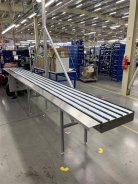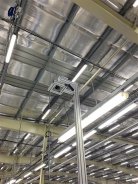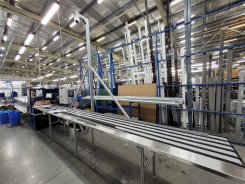Hunter Douglas expands the number of Kinali helpers
It has been several years since Hunter Douglas ordered the first machine for measuring the length of shading profiles from us. As the company and its production grows, so does the need to handle the inspection of more and more metal profiles. That's why the client approached us again at the end of 2021 to design another single-purpose machine, with an even higher capacity than the previous machine.
And this June, we delivered a twin to the second machine in the series. In total, that makes three Kinali machines helping out at Hunter Douglas.
New addition to production with higher capacity
The new orders for 2022 (second and third machine) have resulted in redesigned single-purpose, multi-path measuring machines that can measure up to five metal profiles at a time. In designing them, we again sought a minimalist solution with the best possible price-performance ratio, without affecting functionality, of course. The resulting machines, like the first one, are equipped with only one industrial camera. In similar solutions, competitors commonly use six to eight industrial cameras, which makes the resulting machine significantly more expensive.
Even with one camera, the machines are able to meet the client's high requirements for accuracy and variability of measurement. Whether it is the measurement deviation, which can be a maximum of 5 millimetres, or the ability to measure profiles over a wide range of lengths (250 mm to 5,000 mm). The very first machine was also able to recognise the type, colour and shape of the material.
The machine's functions and capabilities are fully integrated with the client's other workflow, hardware and software applications (including ERP for process control). As a result, the client is better able to maximize the utilization of each metal profile entering production and, in turn, minimize the amount of unused waste. Any residue after production is always measured to update the amount of material in stock.
The colour sorting of profiles in and out of production also simplifies the orientation of production staff in the environment, thus speeding up the entire production process. The so-called Pick to light or Put to light system, known from logistics, helps production workers to easily determine where to take the input material from, where to place the finished product and where to place any leftovers from production. These can be used for another job or disposed of if the leftover material is too short.
Lovers of playing were so happy
As usual, the colleagues had a blast making, programming and testing the new machine. The other owner and developer Kinali Honza was also involved. You can see him in the video playing with the crayons while testing the functionality of the machine. So who thinks that manufacturing industrial machines can't be fun, hasn't experienced manufacturing at Kinali. :)




 MENU
MENU









